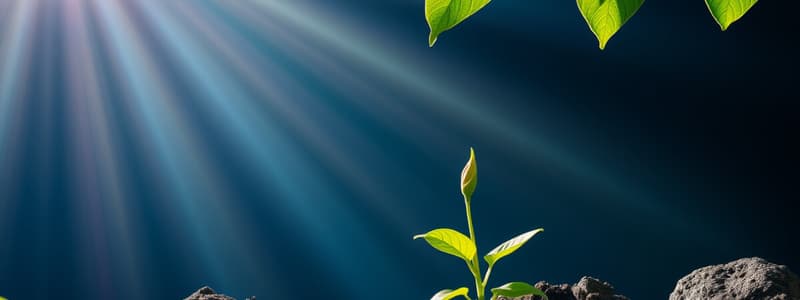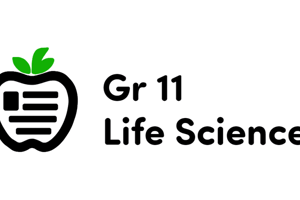Podcast
Questions and Answers
What is the definition of autotroph?
What is the definition of autotroph?
- Decomposer that breaks down organic material
- Self-feeder that synthesizes its own glucose (correct)
- Organism that cannot produce its own food
- Consumer that lives on compounds produced by other organisms
What is the definition of a heterotroph?
What is the definition of a heterotroph?
- Consumer that lives on compounds produced by other organisms (correct)
- Organism that only decomposes matter
- Self-feeder
- Producer that synthesizes its own glucose
What is a granum?
What is a granum?
A stack of thylakoids
What is the definition of stroma?
What is the definition of stroma?
Using 18O as a basis, explain how oxygen released in photosynthesis comes from water.
Using 18O as a basis, explain how oxygen released in photosynthesis comes from water.
What occurs in the light reactions stage of photosynthesis?
What occurs in the light reactions stage of photosynthesis?
Explain the Calvin cycle.
Explain the Calvin cycle.
What are the inputs and outputs into the thylakoid?
What are the inputs and outputs into the thylakoid?
What are the inputs and outputs into the stroma?
What are the inputs and outputs into the stroma?
What are absorption spectra?
What are absorption spectra?
What is the action spectrum?
What is the action spectrum?
How did Engelmann form an action spectrum before the invention of a spectrophotometer?
How did Engelmann form an action spectrum before the invention of a spectrophotometer?
A photosystem is composed of a protein complex called a ____ surrounded by several _____.
A photosystem is composed of a protein complex called a ____ surrounded by several _____.
What is the reaction center complex?
What is the reaction center complex?
What are the advantages of the light harvesting complex?
What are the advantages of the light harvesting complex?
What is the primary electron acceptor?
What is the primary electron acceptor?
What is photosystem I also known as?
What is photosystem I also known as?
What is photosystem II also known as?
What is photosystem II also known as?
What happens as electrons fall between PSII and PSI?
What happens as electrons fall between PSII and PSI?
What is the order of electron flow from PSII primary electron acceptor to PSI?
What is the order of electron flow from PSII primary electron acceptor to PSI?
What is the order of electron flow from PSI primary electron acceptor to NADPH?
What is the order of electron flow from PSI primary electron acceptor to NADPH?
What is chemiosmosis?
What is chemiosmosis?
What is the purpose of the excited electrons leaving PSII?
What is the purpose of the excited electrons leaving PSII?
Why is cyclic electron flow considered evolutionarily significant?
Why is cyclic electron flow considered evolutionarily significant?
How does cyclic electron flow benefit organisms?
How does cyclic electron flow benefit organisms?
What are the similarities between chemiosmosis in photosynthesis and cellular respiration?
What are the similarities between chemiosmosis in photosynthesis and cellular respiration?
What are two differences of chemiosmosis between photosynthesis and cellular respiration?
What are two differences of chemiosmosis between photosynthesis and cellular respiration?
What is the first step of linear electron flow in light reactions?
What is the first step of linear electron flow in light reactions?
What is the second step of linear electron flow in the light reactions?
What is the second step of linear electron flow in the light reactions?
What happens in the third step of linear electron flow during light reactions?
What happens in the third step of linear electron flow during light reactions?
What occurs in the fourth step of linear electron flow during light reactions?
What occurs in the fourth step of linear electron flow during light reactions?
What is the fifth step of linear electron flow in light reactions?
What is the fifth step of linear electron flow in light reactions?
How many turns of the Calvin cycle fix CO2 molecules for one net G3P?
How many turns of the Calvin cycle fix CO2 molecules for one net G3P?
Explain the important events in the carbon fixation stage of the Calvin cycle.
Explain the important events in the carbon fixation stage of the Calvin cycle.
What is Rubisco?
What is Rubisco?
What happens during the reduction stage of the Calvin cycle?
What happens during the reduction stage of the Calvin cycle?
What is formed after fixing 3 CO2 using rubisco?
What is formed after fixing 3 CO2 using rubisco?
Why does it take 3 turns of the Calvin cycle to produce only one net G3P?
Why does it take 3 turns of the Calvin cycle to produce only one net G3P?
How is RuBP regenerated in the Calvin cycle?
How is RuBP regenerated in the Calvin cycle?
What is the first product of C3 plants?
What is the first product of C3 plants?
What happens to a plant during photorespiration?
What happens to a plant during photorespiration?
What is the problem with photorespiration in agriculture?
What is the problem with photorespiration in agriculture?
What is the first product of C4 plants?
What is the first product of C4 plants?
What is the role of PEP carboxylase in C4 plants?
What is the role of PEP carboxylase in C4 plants?
Describe the structure of C4 plants.
Describe the structure of C4 plants.
Why did C4 plants evolve?
Why did C4 plants evolve?
What do CAM plants do?
What do CAM plants do?
What does CAM stand for?
What does CAM stand for?
Explain why only the green cells of a plant are autotrophs.
Explain why only the green cells of a plant are autotrophs.
What are the three parts of Calvin cycle reactions?
What are the three parts of Calvin cycle reactions?
What are the three parts of light reactions?
What are the three parts of light reactions?
What is the most abundant organic molecule in the plant?
What is the most abundant organic molecule in the plant?
After arriving at non-photosynthetic cells, what does sucrose do?
After arriving at non-photosynthetic cells, what does sucrose do?
What is the similarity between C4 and CAM plants?
What is the similarity between C4 and CAM plants?
What are the differences between C4 and CAM plants?
What are the differences between C4 and CAM plants?
Flashcards are hidden until you start studying
Study Notes
Photosynthesis Overview
- Autotrophs are self-feeders that synthesize their own glucose, whereas heterotrophs are consumers reliant on other organisms for organic compounds.
- Granum consists of a stack of thylakoids, while stroma is a thick fluid within chloroplasts where sugars are synthesized during the Calvin cycle.
Oxygen Production
- 18O isotope tracing demonstrated that oxygen released during photosynthesis originates from water.
Light Reactions
- Light energy is converted into chemical energy in the light reactions.
- Water is split, releasing electrons (e-), hydrogen ions (H+), and O2; electrons reduce NADP+ to form NADPH, while H+ ions help synthesize ATP.
Calvin Cycle
- ATP and NADPH fuel the Calvin cycle, converting three CO2 molecules into one net G3P molecule, a precursor to glucose.
- Inputs of the thylakoid are light and water, while the stroma inputs CO2 and outputs sugar.
Light Absorption
- Absorption spectra signify the range of light wavelengths a pigment captures; chlorophyll b absorbs from 410-510 nm in purple and blue ranges.
- Action spectra measure the effectiveness of various wavelengths for photosynthesis, noting that green light is least effective since it is reflected.
Photosystems
- Photosystems consist of a reaction-center complex surrounded by light-harvesting complexes, enabling energy absorption over broad wavelengths.
- Photosystem I (P700) and II (P680) are designated by the preferred wavelengths they absorb.
Electron Transport Chain
- Electrons travel from the primary electron acceptor of PSII through a sequence of carriers to PSI, where energy from their movement is used to pump H+ ions and create a gradient.
- Key players in the electron flow include plastoquinone (Pq), cytochrome complex, and ferredoxin (Fd).
Chemiosmosis
- Chemiosmosis refers to ion movement across membranes, generating ATP through a proton gradient facilitated by ATP synthase.
- Both photosynthesis and cellular respiration utilize similar chemiosmotic processes but differ in their sources of protons and ATP synthase locations.
Carbon Fixation
- RuBisCO catalyzes the initial step of carbon fixation in the Calvin cycle, converting CO2 and RuBP into 3-phosphoglycerate (3-PGA).
- The cycle requires three turns to net one G3P, with five G3P molecules reconfigured to regenerate RuBP.
Photorespiration and Plant Types
- C3 plants' initial product of carbon fixation is 3-phosphoglycerate.
- Photorespiration occurs under stress from closed stomata, causing rubisco to bind O2 instead of CO2, leading to carbon loss and decreased yields.
C4 and CAM Photosynthesis
- C4 plants initially produce a 4-carbon compound using PEP carboxylase to efficiently fix CO2 without engaging in photorespiration by separate spatial pathways.
- CAM plants fix CO2 at night, converting it to organic acids, which are released during the day for the Calvin cycle, aiding water conservation in arid conditions.
Plant Structures and Functions
- The most abundant organic molecule in plants is cellulose, which serves as a key structural component.
- Sucrose acts as a transport molecule for photosynthate, providing energy for cellular respiration and building blocks for various organic compounds.
Summary of Processes
- The Calvin cycle occurs in the stroma, using ATP and NADPH to convert CO2 into G3P while returning ADP and NADP+ to the light reactions.
- Light reactions take place in the thylakoid membranes, generating ATP and NADPH while splitting water and releasing oxygen.
Comparisons and Differences
- Both C4 and CAM plants convert CO2 to organic acids but do so through different timing and structural methods.
- The adaptation of C4 plants allows them to thrive in high-temperature environments with minimized photorespiration effects.
Studying That Suits You
Use AI to generate personalized quizzes and flashcards to suit your learning preferences.




